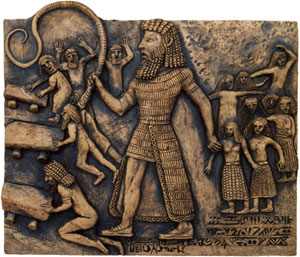One of the most common themes of literature is male comradeship. Male comradeship is the relationship between male characters who share one’s interests, activities and gaining the trust of one another. In the Epic of Gilgamesh and Hamlet by William Shakespeare, the theme is depicted through each story by two primary male characters. These great works illustrate comradery by depicting the heart of their stories and by conveying multiple expressions of loyalty, trust, as well as brotherly love.

In the Epic of Gilgamesh, the two primary characters who share a male comradery are Gilgamesh and Enkidu. Gilgamesh is the king of Uruk, who was the strongest of men, “Two-thirds of him was divine, one-third of him was human!” (Tablet I). Enkidu is the companion who was raised in the jungle by animals. Both were very similar in terms of their physical characteristics such as height and physical strength. The moment they encountered each other, they aspired to become rivals. The pair wrestled and fought to respect one another’s strength. At the end of the battle, “They kissed each other and made friends”, they saw that they could be no winner and they became comrades (Tablet II). The relationship between Gilgamesh and Enkidu is much more impactful on Gilgamesh rather than Enkidu. Even though Enkidu is the uncivilized one who was trying to learn how mankind lives in a new environment with other humans rather than being in a jungle with animals. Before meeting his comrade, Enkidu, he was very unstable, almost uncontrollable. “Day and night he would rampage fiercely.” (Tablet I). Gilgamesh comes to understand and learn what it means to be mortal. This is depicted when they both sought out to defeat Humbaba, the forest orge and Bull of Heaven. After both battles, both Gilgamesh and Enkdu realized that they were mortals. Gilgamesh and Enkidu were disrespectful towards Ishtar the goddess by means of childish acts. In addition, they defied Enlil, the god of Earth, Wind and Air, by killing his servant Humbaba. Enkidu was punished by death.

Enkidu’s death stunned Gilgamesh. “Tearing out and hurling away the locks of his hair, Ripping off and throwing away his fine clothes like something foul” (Tablet VIII). He ripped his clothes and hair off. Gilgamesh lamented to his friend. The beginning of the weeping is filled with imagery of animals and nature. For example, “Onagers raised you on their milk, And the wild beasts taught you all the grazing places.” This quote expresses the life of Enkidu before meeting Gilgamesh. The lamentation is almost like a timeline from beginning to end. As the lamentation progresses, the imagery invokes the life of living in Uruk. For instance, “May the shepherd and herdsman weep for you, Who held the milk and the buttermilk to your mouth” (Tablet VIII. Volume A pg 133). The Epic of Gilgamesh suggests that death is inescapable. The idea of death to Gilgamesh is almost nonexistent before Enkidu’s death. When they were together, the fear of death was not present because they distracted each other from it. “Their actions influenced one another into believing that they were completely immortal. The dynamic of male comradery between these two characters ultimately leads to one character’s death and another’s triumph.

In Hamlet, the male comrades are Hamlet and Horatio. Hamlet is the main protagonist of this tragedy. He is the cruel and cynical Prince of Denmark. Horatio is Hamlet’s trusted friend from the university they attend. But how does Horatio become the trusted friend of the Prince of Denmark. In the tragedy of Hamlet, Horatio’s role in the play is minor. However, his role to the character development of Hamlet is key and crucial part. Horatio serves two purposes to Hamlet. The first being the obvious which is being his closest companion. They share deep conversations that allow the audience to have an insight into Hamlet’s true feelings. These deep conversations can include Hamlet’s soliloquies where Hamlet expresses his thinking to the audience. The second is being the outside spectator to the madness for both the audience and to Hamlet. When Horatio accepted the Ghost’s existence during the first scene of Act I, it is recognized that Hamlet has seen the ghost King of Denmark. If Horatio wasn’t there, Hamlet’s sanity and judgment would be in doubt throughout the story.
At the end of the tragedy of Hamlet, it is the main protagonist that dies unlike the Epic of Gilgamesh where Enkidu died and not Gilgamesh. When Hamlet lies dying, Horatio shows his love for his dying friend by preparing himself to commit suicide. However, Horatio states at the end of the tragedy, “Of that I shall have also cause to speak, And from his mouth whose voice will draw on more” which helps decides Horatio to live in order to tell Hamlet’s story (Act V, scene II. Volume C pg 751). They both share death scenes where one character is holding another in their arms.

The theme of comradeship is thoroughly expressed throughout these two works of literature. Overall, the development within these characters are highly effected by another character with common interests. Today, male comradeship is often expressed as “bromance” which is brotherly love.
